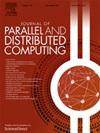基于FPGA的室内物体检测的深度嵌入式轻量级CNN网络
IF 3.4
3区 计算机科学
Q1 COMPUTER SCIENCE, THEORY & METHODS
引用次数: 0
摘要
室内目标检测与识别是计算机视觉和人工智能领域一个活跃的研究方向。各种基于深度学习的技术可以应用于解决目标检测问题。随着深度卷积神经网络(deep convolutional neural networks, DCNN)的出现,在各种应用上取得了很大的突破。室内目标检测是帮助盲人和视障人士(BVI)导航的主要任务。然而,建立一个可靠的室内目标检测系统用于边缘设备的实现仍然是一个严峻的挑战。针对这一问题,本文提出构建一个基于DCNN网络的室内目标检测系统。检测过程采用跨阶段局部网络(CSPNet),采用基于EfficientNet v2的轻量级骨干网作为网络骨干网。为了确保所提出的工作在FPGA器件上的轻量级实现,各种优化技术被应用于压缩模型尺寸并降低其计算复杂度。所提出的室内目标检测系统在Xilinx ZCU 102板上实现。在包含25个地标类的1.1万幅图像的室内目标数据集和室内目标检测数据集上进行了训练和测试实验。提出的工作在原始版本中实现了82.60 mAP和28 FPS,压缩版本实现了80.04和35 FPS的处理速度。本文章由计算机程序翻译,如有差异,请以英文原文为准。
Deep embedded lightweight CNN network for indoor objects detection on FPGA
Indoor object detection and recognition present an active research axis in computer vision and artificial intelligence fields. Various deep learning-based techniques can be applied to solve object detection problems. With the appearance of deep convolutional neural networks (DCNN) a great breakthrough for various applications was achieved. Indoor object detection presents a primary task that can assist Blind and Visually Impaired persons (BVI) during their navigation. However, building a reliable indoor object detection system used for edge device implementations still presents a serious challenge. To address this problem, we propose in this work to build an indoor object detection system based on DCNN network. Cross-stage partial network (CSPNet) was used for the detection process and a lightweight backbone based on EfficientNet v2 was used as a network backbone. To ensure a lightweight implementation of the proposed work on FPGA devices, various optimization techniques have been applied to compress the model size and reduce its computation complexity. The proposed indoor object detection system was implemented on a Xilinx ZCU 102 board. Training and testing experiments have been conducted on the proposed indoor objects dataset that counts 11,000 images containing 25 landmark classes and in indoor objects detection dataset. The proposed work achieved 82.60 mAP and 28 FPS for the original version and 80.04 with 35 FPS as processing speed for the compressed version.
求助全文
通过发布文献求助,成功后即可免费获取论文全文。
去求助
来源期刊

Journal of Parallel and Distributed Computing
工程技术-计算机:理论方法
CiteScore
10.30
自引率
2.60%
发文量
172
审稿时长
12 months
期刊介绍:
This international journal is directed to researchers, engineers, educators, managers, programmers, and users of computers who have particular interests in parallel processing and/or distributed computing.
The Journal of Parallel and Distributed Computing publishes original research papers and timely review articles on the theory, design, evaluation, and use of parallel and/or distributed computing systems. The journal also features special issues on these topics; again covering the full range from the design to the use of our targeted systems.
 求助内容:
求助内容: 应助结果提醒方式:
应助结果提醒方式:


